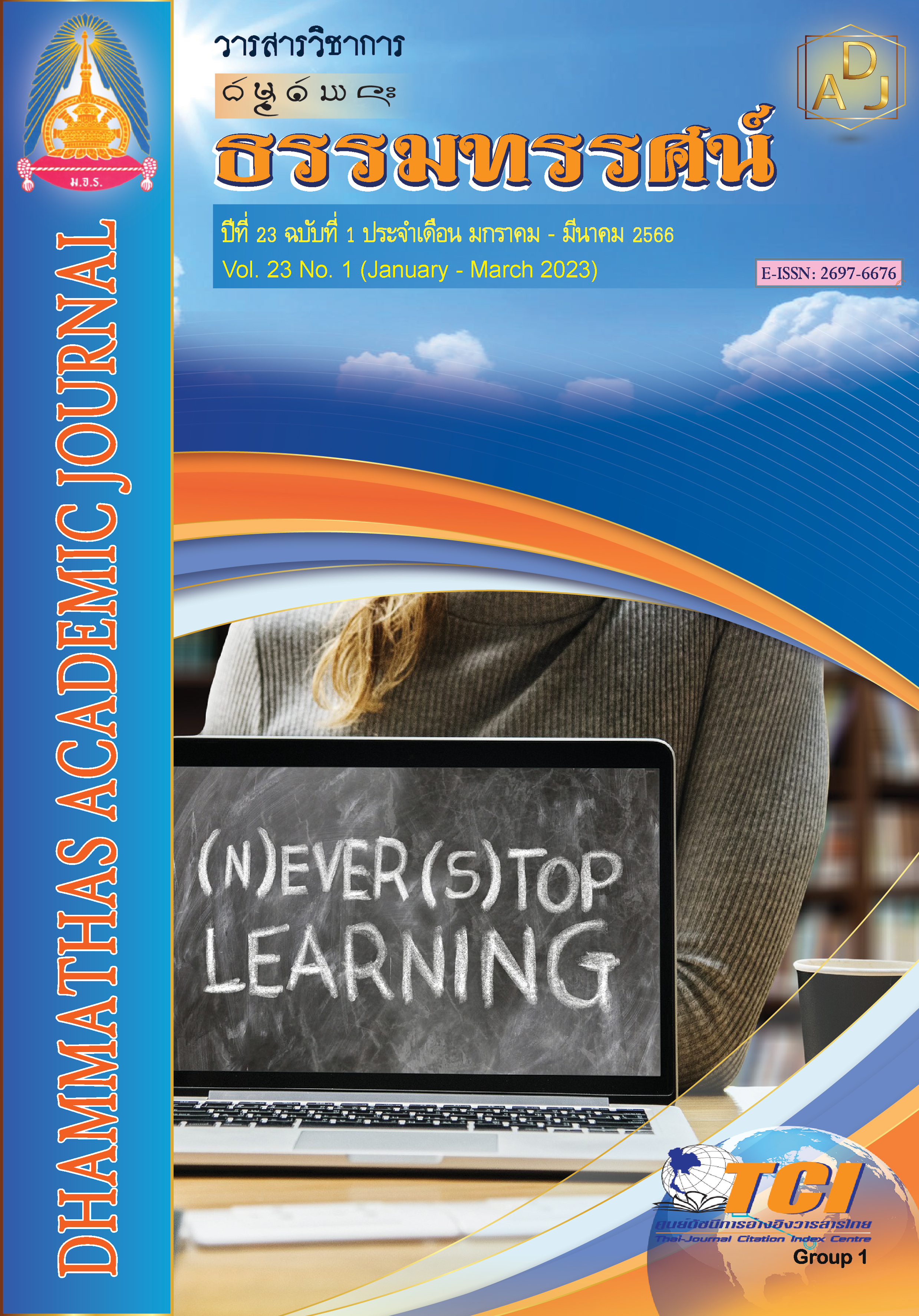The Creation of a Process of Forest Conservation Participation of Monks and Communities in Line with the Buddhist Way of Life in Huai Yang Sub-District Municipality, Kranuan District, Khon Kaen Province
Main Article Content
Abstract
The objectives of this research were: 1) to study the participation in forest conservation of monks and people according to Buddhist way; 2) to study the process of forest conservation of monks and communities according to the Buddhist way of Huai Yang Sub-District Municipality, Kranuan District, Khon Kaen Province; 3) to study the creation of a participation process in forest conservation of monks and communities in line with the Buddhist way of life in Huai Yang Sub-District Municipality, Kranuan District, Khon Kaen Province. This study was qualitative research carried out by analyzing documents and interviewing a target group of 30 key informants. The obtained data were interpreted by Descriptive Analysis.
The research results were as follows:
1. Participatory forest conservation by having village monks Government agencies and private organizations together in forest conservation based on the benefits that will occur in the future belief and religion Public mind and social crisis with forests and networking with people outside the community, both government and NGOs.
2. The process of building and conserving the monks' forests according to the Buddhist way by playing an important role in the existence of the community as villagers view monks as sacrificing ascetics for the benefit of the people wise man in various academic fields.
3. Process creation Participation in forest conservation of monks and communities in line with Buddhist way of life in Huai Yang Sub-District Municipality, Kranuan District, Khon Kaen Province Monks have conservation and forest planting according to academic principles. Community forests are useful for studying and practicing Dharma, both the government and the Sangha, supporting the power of Bowon (houses, temples, schools), bringing outsiders to educate and organizing a forum with the community, continually.
Article Details

This work is licensed under a Creative Commons Attribution-NonCommercial-NoDerivatives 4.0 International License.
เพื่อให้เป็นไปตามกฎหมายลิขสิทธิ์ ผู้นิพนธ์ทุกท่านต้องลงลายมือชื่อในแบบฟอร์มใบมอบลิขสิทธิ์บทความ ให้แก่วารสารฯ พร้อมกับบทความต้นฉบับที่ได้แก้ไขครั้งสุดท้าย นอกจากนี้ ผู้นิพนธ์ทุกท่านต้องยืนยันว่าบทความ ต้นฉบับที่ส่งมาตีพิมพ์นั้น ได้ส่งมาตีพิมพ์เฉพาะในวารสาร วิชาการธรรม ทรรศน์ เพียงแห่งเดียวเท่านั้น หากมีการใช้ ภาพหรือตารางของผู้นิพนธ์อื่นที่ปรากฏในสิ่งตีพิมพ์อื่นมาแล้ว ผู้นิพนธ์ต้องขออนุญาตเจ้าของลิขสิทธิ์ก่อน พร้อมทั้ง แสดงหนังสือที่ได้รับการยินยอมต่อบรรณาธิการ ก่อนที่บทความจะได้รับการตีพิมพ์References
กรมการศาสนา. (2539). คู่มือการปฏิบัติงานด้านศาสนา. กรุงเทพฯ: กรมการศาสนา.
ประสพสุข พันธ์ประยูร. (2535). บทบาทของพระสงฆ์ในการอนุรักษ์ทัพยากรป่าไม้ ในจังหวัดภาคเหนือของประเทศไทย. (วิทยานิพนธ์วิทยาศาสตรมหาบัณฑิต). กรุงเทพฯ: มหาวิทยาลัยเกษตรศาสตร์.
พรชุลี อาชวอำรุง และคณะ. (2549). โครงการศึกษาวิจัยการศึกษาทบทวนโครงการครู พระสอนศีลธรรมในโรงเรียน กรมการศาสนา กระทรวงวัฒนธรรม. (รายงานฉบับย่อ). กรุงเทพฯ: ชุมชนสหกรณ์การเกษตรแห่งประเทศไทย.
พระเทพเวที (ประยุทธ์ ปยุตฺโต). (2534). พระกับป่ามีปัญหาอะไร. กรุงเทพฯ: เรือนแก้ว.
พระธรรมโกศาจารย์ (พุทธทาส อินฺทปญฺโญ). (2535). พระสงฆ์กับการอนุรักษ์ป่า. นิตยสารเสขิยธรรม, 9(2), 18.
พระธรรมปิฎก (ป.อ. ปยุตฺโต). (2543). พจนานุกรมพุทธศาสน์ ฉบับประมวลศัพท์. (พิมพ์ครั้งที่ 9). กรุงเทพฯ: มหาจุฬาลงกรณราชวิทยาลัย.
พระบูรกรณ์ บริบูรณ์. (2539). ป่าไม้ที่ปรากฏในคัมภีร์พุทธศาสนาและความเชื่อของชาวบ้าน. กรุงเทพฯ: มหาวิทยาลัยมหิดล.
พระมหาธีระวุฒิ ธีรธมฺโม (โสมเกษตรินทร์). (2543). บทบาทของพระสงฆ์สื่อบุคคลในการชี้นำและปลูกจิตสำนึกประชาชนชนบทเพื่อการมีส่วนร่วมในการอนุรักษ์ทรัพยากรป่าไม้: ศึกษาเฉพาะกรณีพระสังฆาธิการระดับเจ้าอาวาส จังหวัดอุบลราชธานี. (วิทยานิพนธ์พุทธศาสตรมหาบัณฑิต). พระนครศรีอยุธยา: มหาวิทยาลัยมหาจุฬาลงกรณราชวิทยาลัย.
ภัทรพร สิริกาญจน์. (2536). หน้าที่ของพระสงฆ์ตามพุทธบัญญัติ: แนวคิดและบทบาทของพระคำเขียน สุวณฺโณ ในการพัฒนาชุมชน. กรุงเทพฯ: มหาวิทยาลัยธรรมศาสตร์.
มหาจุฬาลงกรณราชวิทยาลัย. (2539). พระไตรปิฎกภาษาไทย ฉบับมหาจุฬาลงกรณราชวิทยาลัย. กรุงเทพฯ: มหาจุฬาลงกรณราชวิทยาลัย.

